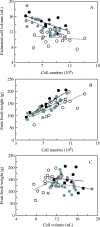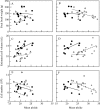Analysis of the tomato fruit growth response to temperature and plant fruit load in relation to cell division, cell expansion and DNA endoreduplication
- PMID: 15582899
- PMCID: PMC4246789
- DOI: 10.1093/aob/mci042
Analysis of the tomato fruit growth response to temperature and plant fruit load in relation to cell division, cell expansion and DNA endoreduplication
Abstract
Background and aims: To better understand the regulation of fruit growth in response to environmental factors, the effects of temperature and plant fruit load on cell number, cell size and DNA endoreduplication were analysed.
Methods: Plants were grown at 20/20 degrees C, 25/25 degrees C and 25/20 degrees C day/night temperatures, and inflorescences were pruned to two ('2F') or five ('5F') flowers.
Key results and conclusions: Despite a lower fruit growth rate at 20/20 degrees C, temperature did not affect final fruit size because of the compensation between cell number and size. The higher cell number at 20/20 degrees C (9.0 x 10(6) against 7.9 x 10(6) at 25/25 degrees C and 7.7 x 10(6) at 25/20 degrees C) resulted from an extended period of cell division, and the smaller cell size was due to a shorter period of expansion rather than a lower expansion rate. By contrast, the lower fruit growth rate and size of 5F fruits compared with 2F fruits resulted from the slow down of cell expansion, whereas the number of cells was hardly affected in the proximal fruit. However, within the inflorescence the decreasing gradient of fruit size from proximal to distal fruits was due to a decrease in cell number with similar cell size. Fruit size variations within each treatment were always positively correlated to variations in cell number, but not in cell size. Negative correlations between cell size and cell number suggested that cells of tomato pericarp can be seen as a population of competing sinks. Mean ploidy was slightly delayed and reduced in 5F fruits compared with 2F fruits. It was highest at 25/25 degrees C and lowest at 25/20 degrees C. Treatments did not affect ploidy and cell size in similar ways, but within each treatment, positive correlations existed between mean ploidy and cell size, though significant only in the 2F-25/20 treatment.
Figures






References
-
- Adams SR, Cockshull KE, Cave CRJ. 2001. Effect of temperature on the growth and development of tomato fruits. Annals of Botany 88: 869–877.
-
- Adams SR, Valdés VM. 2002. The effect of periods of high temperature and manipulating fruit load on the pattern of tomato yields. Journal of Horticultural Science 77: 461–466.
-
- Bangerth F, Ho LC. 1984. Fruit position and fruit set sequence in a truss as factors determining final size of tomato fruits. Annals of Botany 53: 315–319.
-
- Bergervoet JHW, Verhoeven HA, Gilissen LJW, Bino RJ. 1996. High amounts of nuclear DNA in tomato (Lycopersicon esculentum Mill.) pericarp. Plant Science 116: 141–145.

